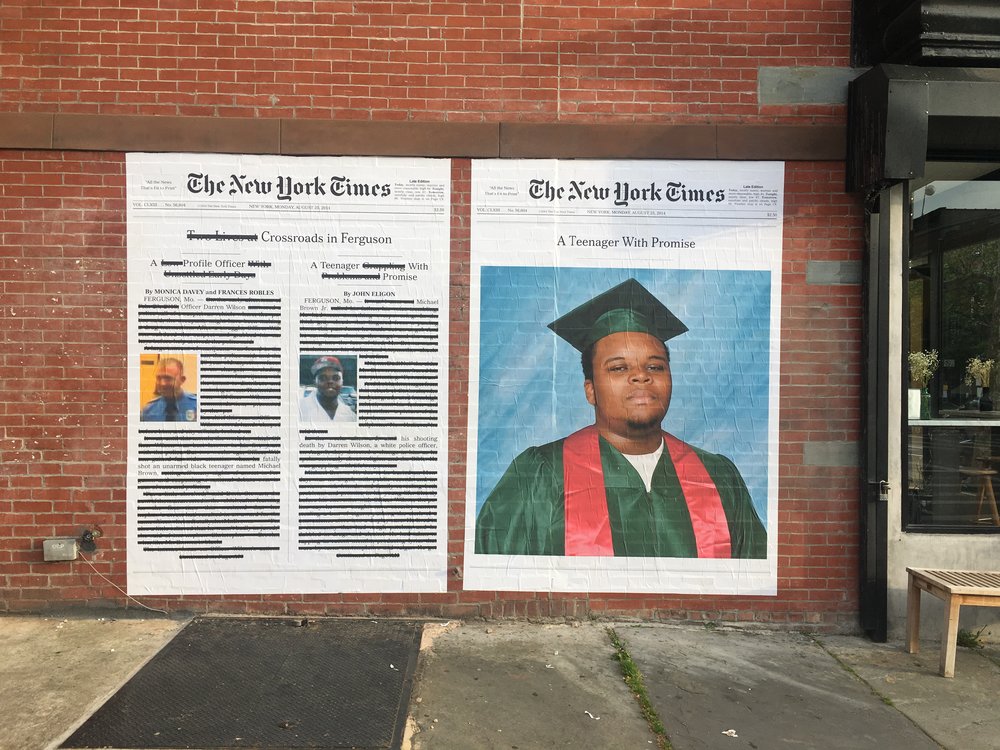Alexandra Bell’s Counternarratives exposes the racial bias present in the news sources we trust the most.
The New York Times. Washington Post. Wall Street Journal. These are our go-to sources for news. We use these news outlets to learn about current events and even cite them in our academic papers. Why? Because we trust them. After all, the Times, the Post, and Journal are among the most reputable and influential newspapers in the nation. But at what cost? How much can we really trust them?
Alexandra Bell, an American multidisciplinary artist, digs into this question. Through her project Counternarratives, Bell examines the ways in which reporting by the nation’s leading newspapers reflect deep-seated racial biases against people of color.
Alexandra Bell uses media and art to expose how leading newspapers’ layout, format, word choice and story selection are laden with racial bias and marginalize people of color. Bell’s work draws back the curtain on the racism that misguides newspapers’ editorial choices and distorts our understanding of current events.
Among numerous examples, Counternarratives critiques The New York Times’s front page reporting of the murder of Michael Brown Jr. in 2014. Upon first look, nothing seems wrong. Of course, it is The New York Times. So why question it? As Bell points out, that is precisely the problem.
Bell first examines the Times’s headline covering the killing: “A Teenager Grappling With Problems and Promise.” Bell resets our perception by editing the title to read simply: “A Teenager With Promise.” The difference? The actual Times headline is loaded with racial bias: A young, murdered black man’s value is diminished by the “problems” of minor drug use and petty misdemeanors. In contrast, Bell’s headline portrays a young black man with a hopeful future. Whether Michael Brown Jr. smoked weed or wrote rap lyrics containing curse words is completely irrelevant to his murder. The story remains the same: a white police officer shot an unarmed young black man six times and killed him. So why did The New York Times choose to headline and highlight superfluous aspects of Michael Brown Jr.’s life? The answer is simple: racial bias. By adding extraneous facts, the Times diminishes Michael Brown’s life and suggests that he was partly responsible for his death. In doing so, the Times takes the focus away from the very racism that killed Michael Brown. Bell doesn’t stop with Michael Brown. She systematically redacts article after article, freeing them of racially biased phrasing and layout.
In the 2016 Times article about white American swimmers fabricating stories of robbery at the Summer Olympics in Brazil, a large picture of Usain Bolt is displayed directly under the headline: Accused of Fabricating Robbery, Swimmers Fuel Tension in Brazil. The problem? Usain Bolt is irrelevant to the story of white swimmers. Yet, he is prominently displayed under a headline about a faked robbery. Why? Is it because he is a black man? In this case, the Times uses racially biased formatting to report the news and tell the facts. The visual reporting, however, is very far from the truth.
Bell forces her audience to engage more critically with the face-value acceptance of recognized news sources through her artistic and critical lens. She provokes the question: How can such credible sources of news present unfair and biased representations of those at the margins? Is this subtle ‘othering’ due to inherent biases that are so ingrained we do not even notice them, or deliberate decisions made by editorial boards? The fact that these racial biases have gone unchecked suggests a deep-rooted stigma against people of color and one that is still widely accepted.
As a person of color reading the nation’s top news sources, I do not expect to be targeted or represented with racially biased language. I just expect to read the news – objective and unbiased news. So, when such credible newspapers either consciously or unconsciously infuse stories involving people of color with racial bias and insidious assumptions, I am once again struck by the extent to which white supremacy is embedded so completely in our lives and institutions. Though I have come to expect that I may be marginalized or targeted in my daily life, when it comes from the most highly trusted news outlets and media, many of which I read, it feels like a betrayal. Alexandra Bell’s Counternarratives addresses this sense of betrayal and makes us ask fundamental questions about the creation and distribution of “news.” Who gets to be in the editorial room? Who gets to tell the news? Which stories are newsworthy?
Bell helps us understand that news that originates in predominantly white and male editorial rooms will inevitably reflect the biases of that dominant group. That is not to say that the individual board members are racist, but it does hint at something deeper: even the “truth” is racially charged. Meaning, what we read and see in the news, what we deem to be the truth, is a product of the very oppression that marginalizes people of color.
Yet, Alexandra Bell’s work suggests that it is not just the editorial boards that should be held accountable, but we all must be. We must read the news with a critical eye and not necessarily as “the truth.” Just because a source or an article has the words “New York Times” stamped across the masthead does not mean we can automatically trust it. For all my fellow people of color readers, stay sharp.




